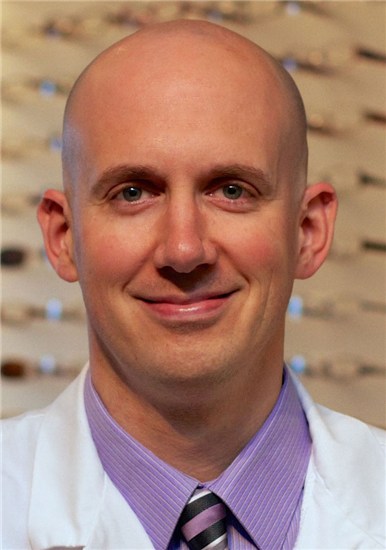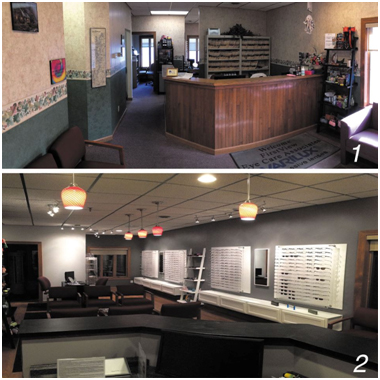By Brett M. Paepke, OD
As anyone who plays a musical instrument can attest, a difficult song or solo is nothing more than a collection of small, easier-to-manage sections. Learn each of the small parts, string them together, and you’re a virtuoso. That same wisdom can be applied to the patient experience within your office. Analyzing each stage of the patient visit allows you to see where you’re hitting all the right notes and where you might need to get back on key. In our practice, for example, a patient-perspective analysis of our dispensary paid off in a one-year increase of 10 percent in revenue-per-patient and capture rate.

Dr. Paepke’s office reception area prior to renovations (top), and after improvements made, based on patient-perspective analysis(bottom). In one year, both capture rate and revenue-per-patient increased 10 percent.
DEFINE YOUR FIVE PATIENT EXPERIENCE STAGES
Our practice defines the patient experience as composed of:
Reception
Pre-Test
Exam
Dispensary
Departure
When you analyze the patient experience in your practice, do sofrom the patient’s perspective. Keep in mind: You’re creating an “experience,” not just delivering a service.
At each office meeting, we address one stage.
As part of the reception stage analysis, for example, we exit the office and re-enter with “fine-toothed combs” looking for weaknesses in the initial impressions. Our needed improvements and the results of our enhancements were guided by the patient satisfaction surveys we conduct multiple times a year.
We try to view things from a patient perspective, identify things that would make the experience at that stage better, implement those changes and then evaluate via survey. Occasionally, a survey respondent will offer suggestions, but the surveys are designed more to assign a numerical score to how we did. If scores slide down, we know we need to re-evaluate.
IN-OFFICE RECEPTION
When we looked at the in-office reception area from a patient perspective, the first impression wasn’t consistent with the modern technology and care we provide. Subsequently, we established a budget, planned and then executed a front office makeover (see before- and after-photo left and above) to revamp that first impression, as well as promote confidence in the care and materials we provide.

The view of Lake Champlain from Dr. Paepke’s office, which takes advantage of the stunning views.
While we were restricted in terms of layout by the physical dimensions of the space, we were able to open the entire front office up allowing the influx of much more natural light and unobstructed views of Lake Champlain and the Green Mountains of Vermont. The front office was converted from a dated decor to one more modern and representative of the experience we want people to have here.
Since the changes, 97 percent of surveyed patients say their “first impression when I walked through the door” is “very positive” (72 percent) or “positive” (25 percent), the top two options on our five-choice scale.
We try to be astute observers and figure things out on our own first, implement the changes we identify, and then “grade” ourselves with patient surveys. As mentioned above, the surveys will occasionally provide suggestions, but it is mainly a statistical tool. We run our 10 question surveys online through SurveyMonkey which allows for easier data collection and analysis.
DISPENSARY & DEPARTURE
Ourrenovation also positivelyimpacted the dispensary and departure stages of the patient encounter. On the dispensary side, the available square footage and visibility increased significantly, leading to a 10 percent increase in both eyeglass sale capture and revenue-per-patient versus the previous year. Ninety-three percent of surveyed patients rated the dispensary as “excellent” (65 percent) or “good” (28 percent) compared to previous years where patients would question if we even had glasses. Patient departure was facilitated by the much more open front office resulting in fewer bottlenecks. This is significant because we absolutely don’t want to ruin an experience by making a patient wait to leave.
PRE-TESTING & EXAM
While the changes to the front office were great for reception, dispensary and departure, they did little beyond setting the tone for the pre-test and exam stages of an encounter that take place elsewhere in the clinic.
When we analyzed pre-testing, we collectively drew on our experiences as patients at other health care providers’ offices and came to the conclusion that the entire stage could be made much more personal with a simple introduction by the technician. None of us could remember the names, or even being told the names, of the people who worked with us prior to the actual provider. This seemed counterintuitive for creating a personal relationship and establishing trust. How significant of a relationship and bond can a patient have with the practice if they don’t know the names of everyone involved in their care? As such, all pre-tests are now started with a self-introduction by the technician. While we don’t have comparative statistics to track the effect this has had, we do know that 100 percent of surveyed patients rated their interaction with their technician as “extremely satisfied” (98 percent) or “moderately satisfied” (2 percent), the top two options of five.
We pride ourselves on investing in the latest instrumentation to improve the quality of care we provide. Whether it’s an OCT to manage a disease process or an anterior segment camera to show a patient why their eye hurts, we have the most up-to-date instruments. But so do many other practices. So when we analyzed the exam stage of the encounter for ways to be different, we felt that a discussion of corneal topography and wavefront aberrometry was the way to go. We were already gathering that data as part of each pre-test, and the analytical software provides fantastic maps that we now use to educate patients about everything from contact lens-related disorders and corneal disease to cataracts. When asked how they would rate their experience with their doctor, 100 percent of our surveyed patients chose the highest rating: “extremely satisfied.”
Today’s eyecare patients are bombarded with options for both care and material purchases. Practices need to critically consider their value proposition to the patients they seek to serve. Staging the patient experience, or breaking it down into smaller parts for easier analysis, facilitates this process. With attention to each note your practice is playing, the greater the chance the resulting song will be music to your patients’ ears.
Patient Experience: Key Ongoing Questions for You and Your Staff
What can you do during each patient experience stage to be different?
What can you do during each stage to positively influence the patient’s perceptions of the practice?
What can you do during each stage to promote loyalty and take the patient out of the marketplace?
What does the practice do between visits to keep itself at the top of the patient’s mind?
Brett M. Paepke, OD, is the co-owner with his father, Charles Paepke, OD, of FirstView Eye Care Associates in Plattsburgh, NY. To contact him: drbmpaepke@firstvieweyecare.com



























